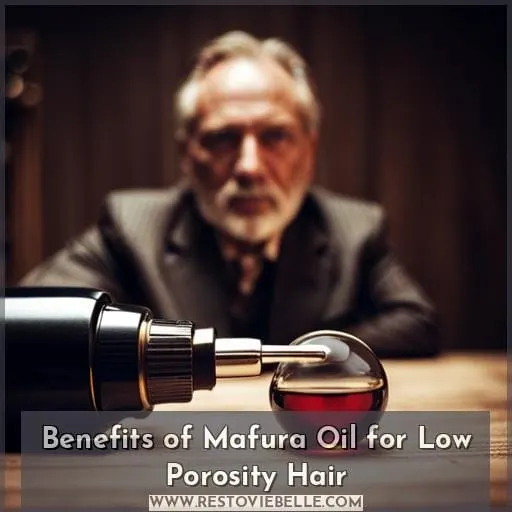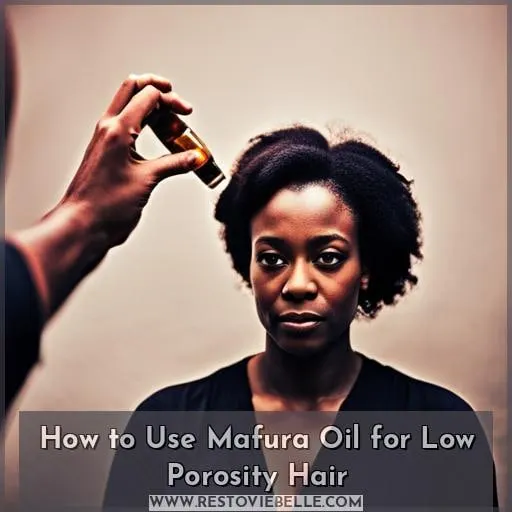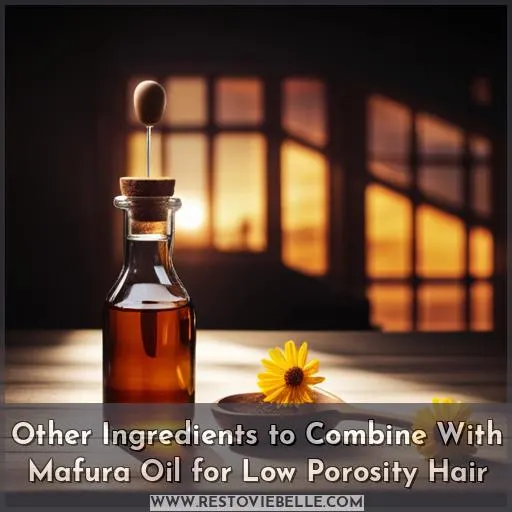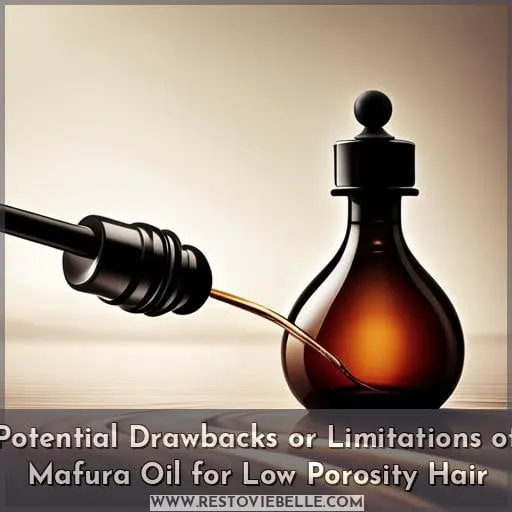This site is supported by our readers. We may earn a commission, at no cost to you, if you purchase through links.
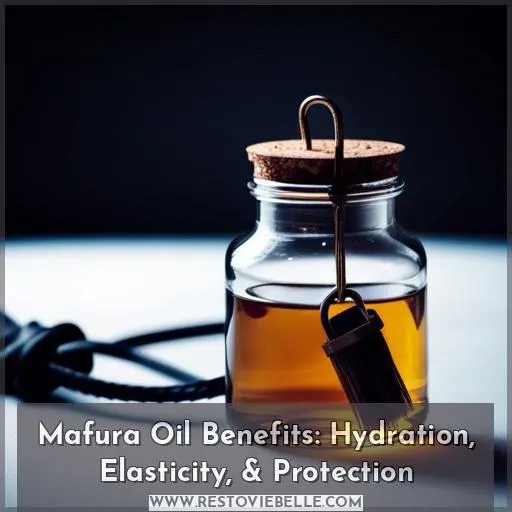 Looking to enhance the health and appearance of your low porosity hair? Look no further than mafura oil. This natural wonder offers a range of benefits, including hydration, improved elasticity, and protection against environmental damage.
Looking to enhance the health and appearance of your low porosity hair? Look no further than mafura oil. This natural wonder offers a range of benefits, including hydration, improved elasticity, and protection against environmental damage.
In this article, we’ll dive into the reasons why mafura oil is good for low porosity hair and how to incorporate it into your hair care routine.
Table Of Contents
- Key Takeaways
- Benefits of Mafura Oil for Low Porosity Hair
- How to Use Mafura Oil for Low Porosity Hair
- Other Ingredients to Combine With Mafura Oil for Low Porosity Hair
- Tips for Choosing and Applying Mafura Oil Products
- Potential Drawbacks or Limitations of Mafura Oil for Low Porosity Hair
- Frequently Asked Questions (FAQs)
- Can Mafura Oil be used on high porosity hair as well?
- How often should Mafura Oil be applied to low porosity hair?
- Are there any potential side effects of using Mafura Oil on low porosity hair?
- Can Mafura Oil be used as a heat protectant for low porosity hair?
- Are there any specific hair types that Mafura Oil is not suitable for?
- Conclusion
Key Takeaways
- Mafura Oil is beneficial for low porosity hair as it provides hydration and moisture.
- It can be used as a pre-shampoo treatment, deep conditioning treatment, or scalp massage.
- Mixing Mafura Oil with ingredients like honey, shea butter, and glycerin can enhance its moisturizing properties.
- It is important to properly rinse out the oil to avoid buildup and potential allergic reactions.
Benefits of Mafura Oil for Low Porosity Hair
If you have low porosity hair, mafura oil can be a beneficial addition to your hair care routine.
One of the main benefits is its ability to provide hydration and moisture to dry strands, helping to combat the characteristic lack of moisture retention in low porosity hair.
Additionally, mafura oil can improve hair elasticity, making it easier for your curls or coils to bounce back and maintain their shape.
Lastly, this oil offers protection against environmental damage by forming a barrier on the surface of the hair shaft.
Hydration and Moisture
Mafura oil effectively hydrates and moisturizes low porosity hair, leaving it soft, nourished, and healthy.
It absorbs moisture into the hair shaft, providing deep hydration from within. This helps to prevent frizz and improve manageability by smoothing the cuticles of the hair.
The oil also aids in detangling by reducing friction between strands.
In addition to its hydrating properties, mafura oil improves shine and softens the hair for a lustrous appearance.
Improved Hair Elasticity
Improve your hair’s elasticity with the benefits of mafura oil for low porosity hair.
- Reduces frizz and prevents breakage
- Boosts shine and helps with detangling
- Improves manageability, making styling easier
Protection Against Environmental Damage
To protect your low porosity hair from environmental damage, mafura oil works wonders.
This natural oil provides UV protection, shielding your hair from the harmful effects of the sun’s rays.
It also offers heat protection, minimizing damage caused by styling tools and hot temperatures.
Additionally, mafura oil helps combat dryness by locking in moisture and preventing frizz and split ends.
With its hydrating properties and protective benefits, mafura oil is a great choice for maintaining healthy low porosity hair.
How to Use Mafura Oil for Low Porosity Hair
To effectively use Mafura oil for low porosity hair, there are three key methods you can try:
First, as a pre-shampoo treatment, apply the oil to your dry hair and leave it on for about 30 minutes before washing.
Second, as a deep conditioning treatment, mix the oil with your regular conditioner or create a DIY hair mask using natural ingredients like honey or avocado.
Lastly, incorporate scalp massages and an oil blend of Mafura oil with other beneficial oils into your routine to promote moisture retention and stimulate blood flow to the scalp.
Pre-Shampoo Treatment
To enhance the benefits of Mafura Oil for low porosity hair, start by incorporating a pre-shampoo treatment into your hair care routine.
This step is crucial in preparing your hair for cleansing and maximizing the absorption of nutrients from the oil.
Apply a leave-in conditioner or hair mask before shampooing to provide extra moisture and protection to your dry, low porosity strands.
This will help improve overall hair health and ensure that your locks are properly hydrated throughout the washing process.
Deep Conditioning Treatment
To effectively use mafura oil for low porosity hair, incorporate it into your deep conditioning treatment.
Mafura oil can be used as a leave-in conditioner, heat protectant, or protein treatment to nourish and hydrate your hair.
By applying a mafura oil hair mask during deep conditioning sessions, you can promote healthy hair growth and enhance the overall condition of your locks.
Make sure to follow the instructions on the product label for best results in achieving optimal hydration and elasticity in your low porosity strands.
Scalp Massage and Oil Blend
Massage your scalp with a small amount of Mafura oil and blend it with other nourishing oils to enhance the benefits for your low porosity hair.
This scalp massage and oil blend can promote circulation, stimulate hair growth, and provide deep hydration to the scalp.
It’s important to use Mafura oil as a leave-in conditioner or incorporate it into homemade hair masques for optimal results.
Remember that Mafura oil is safe for color-treated hair, making it suitable for all types of low porosity locks.
Other Ingredients to Combine With Mafura Oil for Low Porosity Hair
To maximize the benefits of mafura oil for low porosity hair, you can consider combining it with other ingredients such as honey, shea butter, and glycerin.
Honey is a natural humectant that helps attract and retain moisture in the hair.
Shea butter provides deep hydration and nourishment to dry strands.
Glycerin helps to improve moisture retention and enhance the overall softness and manageability of your hair.
Honey
You should regularly incorporate honey into your hair care routine when combining it with mafura oil for low porosity hair.
Honey is known for its numerous benefits, making it a valuable ingredient for promoting healthy hair. It helps to moisturize and hydrate the strands, improving elasticity and preventing breakage. Additionally, honey can stimulate hair growth and reduce hair loss by nourishing the scalp and strengthening the follicles.
When used in combination with mafura oil, honey provides a powerful duo that promotes optimal moisture retention and overall hair health.
Shea Butter
When combining Mafura Oil with other ingredients for low porosity hair, Shea Butter is a fantastic choice due to its nourishing and moisturizing properties.
Shea butter offers numerous benefits for both the hair and skin. It promotes hair growth, deeply hydrates dry strands, improves the appearance of stretch marks, soothes eczema-prone skin, and provides relief for dry skin conditions.
Incorporating shea butter into your Mafura Oil hair masque can help enhance hydration levels and improve overall hair health.
Glycerin
Combining glycerin with mafura oil can further enhance the benefits for low porosity hair, providing even more hydration and moisture retention.
Glycerin is a versatile ingredient known for its hydrating properties. It helps attract and lock in moisture, making it beneficial for both hair and skin.
When used in combination with mafura oil, glycerin can help nourish the hair follicles, improve elasticity, protect against environmental damage, and promote overall healthy-looking locks without weighing them down or causing any side effects.
Tips for Choosing and Applying Mafura Oil Products
When choosing Mafura oil products for your low porosity hair, it’s important to consider the proper application techniques and frequency of use.
To ensure maximum benefits, apply the products from root to ends and leave them on for a recommended amount of time before rinsing thoroughly.
It’s also crucial to follow the instructions provided by each product and tailor your usage based on your hair’s unique needs.
Proper Application Techniques
To properly apply Mafura oil products for low porosity hair, start by gently massaging a small amount of the oil into your scalp and working it through the lengths of your hair.
Here are some tips to keep in mind when applying Mafura oil:
- Use warm oil: Warm up the Mafura oil before application to enhance its absorption.
- Leave on overnight: For an intense treatment, leave the Mafura oil on overnight and rinse out in the morning.
- Work with heat: Apply heat using a steamer or warm towel to help open up cuticles and allow better penetration of the oil.
- Choose suitable products: Look for shampoos, conditioners, or hair masques that contain high-quality mafura oils specifically formulated for thin hair.
By following these proper application techniques with mafura oils designed for thin hair types, you can maximize their benefits and achieve healthier-looking locks.
Frequency of Use
To maximize the benefits of Mafura oil for low porosity hair, it’s important to incorporate it into your hair care routine regularly.
The frequency of use will depend on your specific needs and preferences.
Some people may choose to use Mafura oil daily as a leave-in treatment or as needed for extra hydration and protection.
Others may opt for weekly or biweekly applications to maintain optimal moisture levels and enhance hair elasticity.
Monthly treatments can be beneficial for deep conditioning and nourishing effects.
Adjust the frequency based on how your hair responds to the product’s hydrating properties.
Potential Drawbacks or Limitations of Mafura Oil for Low Porosity Hair
While mafura oil can provide numerous benefits for low porosity hair, there are a few potential drawbacks and limitations to consider.
Firstly, mafura oil is known to be quite heavy and can lead to build-up if not properly rinsed out.
Secondly, some individuals may experience allergic reactions or sensitivities to mafura oil due to its natural composition.
Lastly, the availability of mafura oil products may be limited in certain areas and they can often come with a higher price tag compared to other oils.
Heavy Weight and Build-Up
Continuing from our previous discussion, you may experience heavy weight and build-up when using Mafura oil for low porosity hair.
Due to its rich and thick consistency, Mafura oil has the potential to weigh down your hair strands, making it feel heavy and greasy.
Additionally, if not properly rinsed out or used in excess amounts, Mafura oil can leave behind a residue that leads to build-up on the scalp and hair shafts.
To avoid these issues, it’s essential to use Mafura oil sparingly as a leave-in conditioner or blend it with lighter oils for better absorption by low porosity hair strands.
Allergic Reactions or Sensitivities
If you have low porosity hair, it’s important to be aware of the potential drawbacks or limitations of using Mafura oil, such as allergic reactions or sensitivities.
Some individuals may experience skin irritation, contact dermatitis, or an allergic reaction when using Mafura oil on their hair and scalp.
It’s recommended to perform a patch test before applying the oil directly to your hair and monitor for any signs of skin sensitivity.
Availability and Cost
When looking to incorporate mafura oil into your low porosity hair routine, it’s important to consider the availability and cost of this beneficial ingredient.
Mafura oil can be found at various online retailers, making it easily accessible for purchase.
Small businesses and natural grocers may also carry mafura oil, but they might have a limited selection and higher prices compared to larger retailers like Amazon.
Overall, mafura oil is affordable and widely available for those seeking its hydrating benefits.
Frequently Asked Questions (FAQs)
Can Mafura Oil be used on high porosity hair as well?
Mafura Oil can be used on high porosity hair as well. Its nourishing properties help to seal the cuticles and prevent moisture loss, providing hydration and reducing frizz.
Incorporating Mafura Oil into your hair care routine can improve the health and manageability of high porosity hair.
How often should Mafura Oil be applied to low porosity hair?
To maximize the benefits of Mafura Oil for low porosity hair, it’s recommended to apply it once or twice a week.
This frequency allows for deep hydration and nourishment without overwhelming the hair.
Are there any potential side effects of using Mafura Oil on low porosity hair?
Using Mafura Oil on low porosity hair can be beneficial as it helps to moisturize and nourish the hair. However, there are no known side effects associated with using Mafura Oil specifically on low porosity hair.
Can Mafura Oil be used as a heat protectant for low porosity hair?
Yes, Mafura Oil can be used as a heat protectant for low porosity hair.
Its moisturizing properties help to shield the hair from heat damage while keeping it hydrated and nourished.
Are there any specific hair types that Mafura Oil is not suitable for?
Mafura Oil is suitable for most hair types, including low porosity hair. Its nourishing properties help hydrate and revitalize the strands, promoting softness and shine. However, it may not be ideal for those with extremely oily or fine hair textures.
Conclusion
To sum it up, mafura oil is a game-changer for low porosity hair. With its incredible benefits of hydration, improved elasticity, and protection against environmental damage, this natural wonder is a must-have in your hair care routine.
Incorporating mafura oil into your pre-shampoo treatments, deep conditioning treatments, and scalp massages will leave your hair looking and feeling luscious. Don’t forget to combine it with other ingredients like honey, shea butter, and glycerin for even more nourishment.
Say goodbye to dry, brittle hair and hello to healthy, vibrant locks with mafura oil.
